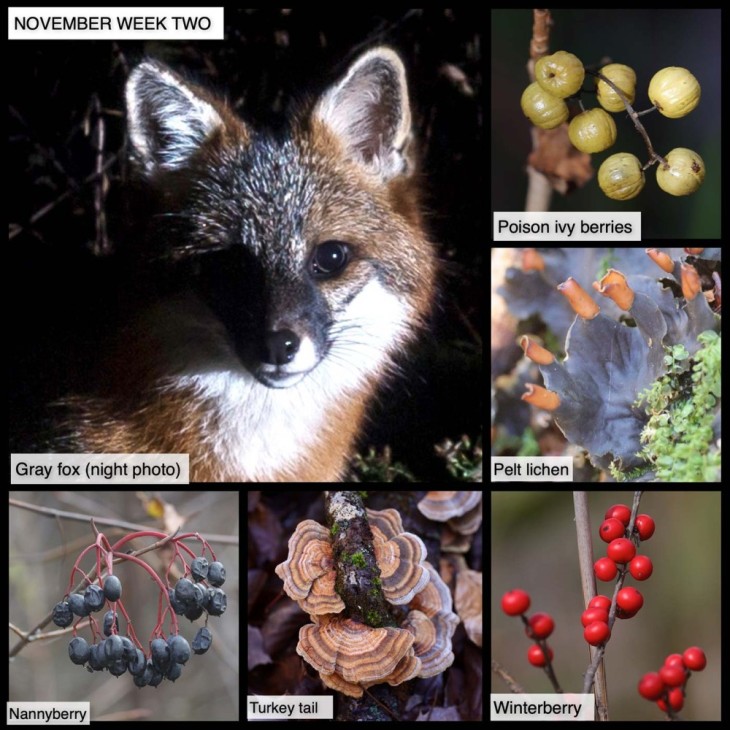This Week in the Woods, a nighttime camera trap at the edge of an apple orchard revealed the presence of a deer, porcupine, and this handsome gray fox. As noted in this Outside Story essay by Meghan McCarthy McPhaul, gray foxes are “tree foxes” that split from their red cousins some 3.6 million years ago, and typically favor forested habitat. Unlike reds, they can climb trees to reach food (including fruit – perhaps the reason for this animal’s visit). Climbing skills also allow them to escape predators, including coyotes.
Here are some other nature sights (clockwise):
Those pretty cream-colored berries with pumpkin-like grooves are poison ivy berries. They’re great wildlife food and pretty to look at, but before you pick them for a table display, be warned that they can pack a punch, causing painful rashes and swelling. Here’s an Outside Story essay by Ned Swanberg from our archive, describing the plant’s wildlife benefits and why poison ivy sap irritates human skin (it contains the compound urushiol). Poison ivy benefits from a warmer, more CO2 rich climate, so we should expect to see more of it in the Northeast.
Pelt lichen often grows in mossy beds, which is where we found this specimen. This is probably many-fruited pelt, distinguished by the numerous fruiting bodies – apothecia – attached to its lobe margins. As noted by Joe Walewski in Lichens of the North Woods, the reproductive function of the apothecia is poorly understood; in theory, the apothecia release fungal spores that fall to the ground and combine with soil cyanobacteria.
At the edge of wetlands, look for brilliant red winterberry fruits, often attended by tiny black flies. As noted in this Outside Story essay by Madeline Bodin, the fruits of this native holly are not a popular autumn food for wildlife, probably in part because they’re so acidic. However, in the starving months of winter, they can be a critical food source for birds, mice, and other creatures.
We found a beautiful clump of orange turkey tail fungus growing on a dead branch, and remembering this Outside Story essay by Meghan McCarthy McPhaul, turned it over to check its underside. Sure enough, it had the “round, spore-bearing pores” described in the essay. As noted by McPhaul, this fungus serves as food for squirrels and other small creatures, and can be used to make tea, “touted for its immune-boosting properties in some cultures.”
Finally, rounding out this week’s berry theme, you can still find nannyberries in abundance, drooping down from pink stems. The fresh fruit and dried raisins of these large viburnums provide excellent wildlife food; as Sue Morse notes in this 2014 article from our archive, over a dozen bird species consume the fruit in the autumn and winter, as do many mammals – including the gray fox who started this week’s post.
Our thanks to The Bailey Charitable Foundation and the Frank and Brinna Sands Foundation for helping to support this series.
In this difficult period, many of us find joy in observing local nature. This series, launched in April 2020, shares nature photographs taken in the past seven days, or in the same week in 2020, most within 15 miles of the Northern Woodlands office in Lyme, New Hampshire. We hope you enjoy using this grid as a prompt for your own explorations.
What are you seeing in the woods this week? Share your images with us on Facebook, or submit a special photo for possible inclusion in our monthly online Reader Photo Gallery.


